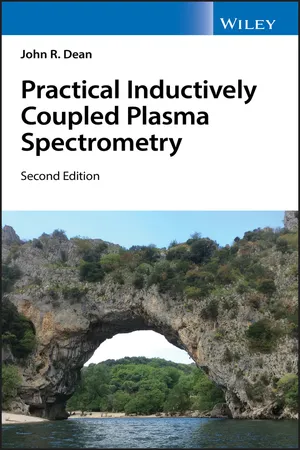
Practical Inductively Coupled Plasma Spectrometry
John R. Dean
- English
- ePUB (handyfreundlich)
- Über iOS und Android verfügbar
Practical Inductively Coupled Plasma Spectrometry
John R. Dean
Über dieses Buch
A new edition of this practical approach to sampling, experimentation, and applications in the field of inductively coupled plasma spectrometry
The second edition of Practical Inductively Coupled Plasma Spectrometry discusses many of the significant developments in the field which have expanded inductively coupled plasma (ICP) spectrometry from a useful optical emission spectroscopic technique for trace element analysis into a source for both atomic emission spectrometry and mass spectrometry, capable of detecting elements at sub-ppb (ng mL ?1 ) levels with good accuracy and precision.
Comprising nine chapters, this new edition has been fully revised and up-dated in each chapter. It contains information on everything you need to practically know about the different types of instrumentation as well as pre- and post-experimental aspects. Designed to be easily accessible, with a 'start-to-finish' approach, each chapter outlines the key practical aspects of a specific aspect of the topic. The author, a noted expert in the field, details specific applications of the techniquespresented, including uses in environmental, food and industrial analysis. This edition:
- Emphasizes the importance of health and safety;
- Provides advanced information on sample preparation techniques;
- Presents an updated chapter on inductively coupled plasma mass spectrometry;
- Features a new chapter on current and future development in ICP technology and one on practical trouble shooting and routine maintenance.
Practical Inductively Coupled Plasma Spectrometry offers a practical guide that can be used for undergraduate and graduate students in the broad discipline of analytical chemistry, which includes biomedical science, environmental science, food science and forensic science, in both distance and open learning situations. It also provides an excellent reference for those in postgraduate training in these fields.
Häufig gestellte Fragen
Information
1
The Analytical Approach
LEARNING OBJECTIVES
- • To be aware of the different types of contamination that can cause problems in trace elemental analysis.
- • To know about Health and Safety in the working environment.
- • To be able to carry out a Risk Assessment for safe laboratory and in‐field practice.
- • To appreciate the units used in analytical chemistry.
- • To be able to report numerical data with the appropriate assignment of significant figures.
- • To be able to present numerical data with correct units and be able to interchange the units as required.
- • To know how to present and report laboratory information in an appropriate format.
- • To be able to determine the concentration of an element from a straight‐line graph using the equation y = mx + c.
- • To be able to calculate the dilution factor for a liquid sample and a solid sample, and hence determine the concentration of the element in the original sample.
- • To appreciate the concept of quality assurance in the analytical laboratory.
- • To be aware of the significance of certified reference materials in elemental analysis.
- • To develop an understanding of reporting and interpreting the data generated in its appropriate context.
1.1 Introduction
- • Health and Safety in the laboratory (and external environment);
- • sampling, sample storage and preservation and sample preparation methodologies appropriate to sample type;
- • analytical technique to be used;
- • data control, including calibration strategies and the use of certified reference materials (CRMs) for quality control and data assurance;
- • data management, including reporting of results and their interpretation, context and meaning.